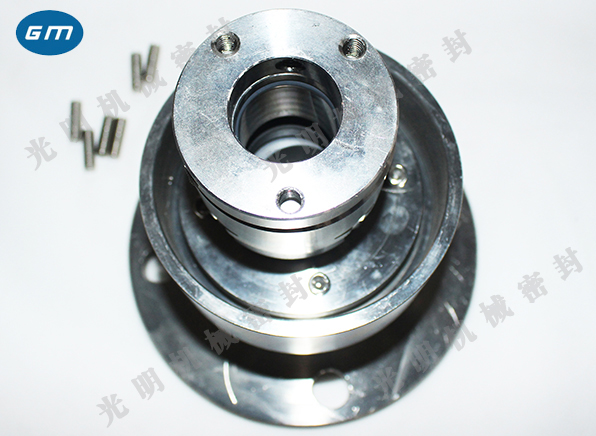204 Mechanical seal manufacturer Tell you the inspection process of mechanical seal!
Mechanical seal maintenance procedure
To master the repair and maintenance of mechanical seal, first of all, you should know the working principle of mechanical seal. The mechanical seal is a sealing device composed of two sealing elements (static ring and dynamic ring) perpendicular to the shaft, smooth and straight surfaces that stick together and rotate relative to each other. It is achieved by the pressure of the sealing medium to generate appropriate compression force on the contact surface (end face) of the rotating dynamic ring and static ring, so that the two end faces can be closely combined, and an extremely thin liquid film is maintained between the end faces. This layer of liquid film has both dynamic and static pressure, which plays the role of lubrication and balance force. The maintenance process of pump mechanical seal mainly includes the following aspects:
1、 Cleaning and inspection of mechanical seal
The working principle of mechanical seal requires that there is no impurity inside the mechanical seal.
Before assembling the mechanical seal, the moving ring, stationary ring, shaft sleeve and other parts shall be thoroughly cleaned. Key inspection:
1. Whether there are scratches, cracks and other defects on the surface of the moving and stationary rings, which will cause serious leakage of the mechanical seal. If possible, special tools can be used to check whether the sealing surface is flat or not. If the sealing surface is uneven, pressure water will enter the sealing surface of the dynamic and static rings of the mechanical seal after assembly, separating the dynamic and static rings, and the mechanical seal will fail. If necessary, tooling can be made for hydrostatic test before assembly.
2. Check whether the rotating and stationary ring seats have defects that affect the sealing. For example, whether there are scars and other defects on the mating surface of the movable and stationary ring seats and the sealing rubber rings of the movable and stationary rings.
3. Check whether the mechanical seal compensation spring is damaged and deformed, and whether the obstinacy coefficient changes.
4. Check whether there are burrs, grooves and other defects in the seal shaft sleeve.
5. Clean and check all sealing rubber rings for cracks, air holes and other defects, and measure whether the diameter of rubber rings is within the working tolerance range.
6. For the mechanical seal with pumping mechanism, check whether the spiral line of the screw pump has cracks, broken lines and other defects.
2、 Technical dimension check of mechanical seal assembly
The maintenance process of mechanical seal is complex. To ensure that the mechanical seal after assembly has no leakage, it is necessary to check the technical dimension of mechanical seal.
1. Measure the dimension of sealing surface of moving ring and stationary ring. This data is used to verify the radial width of the moving and stationary rings. When different friction materials are selected, the radial width of the hard material friction surface should be 1-3 mm larger than that of the soft material, otherwise it is easy to cause the edges and corners of the hard material end face to be embedded in the soft material end face.
2. Check the clearance between the moving ring, stationary ring and shaft or shaft sleeve. The inner diameter of the stationary ring is generally 1-2 mm larger than the shaft diameter. For the moving ring, the inner diameter is 0.5 - 1mm larger than the shaft diameter to ensure the floatability, which is used to compensate for the vibration and deflection of the shaft, but the clearance should not be too large, otherwise the dynamic ring seal ring will be stuck in, causing damage to the mechanical seal function.
3. Check the tightening force of mechanical seal. The mechanical seal tightening force we usually talk about is the end face specific pressure. The end face specific pressure should be appropriate. If it is too large, the friction surface of the mechanical seal will heat up, accelerate the end face wear, and increase the friction power; Too small, easy to leak. The end face specific pressure is determined when the mechanical seal is designed, and we can only determine it by measuring the mechanical seal tightening force when assembling. The normal measurement method is to measure the vertical distance between the installed stationary ring end face and the gland end face, and the difference between the vertical distance between the moving ring end face and the gland end face is the tightening force of the mechanical seal.
4. Measure whether the length of the compensation spring changes. The change of spring performance will directly affect the face pressure of mechanical seal. Generally, the length of the spring will be shortened after a long time of operation, and the mechanical seal of the compensation spring on the moving ring will also be deformed due to centrifugal force.
5. Measure the length of the static ring anti rotation pin and the depth of the pin hole to prevent the pin from being too long and the static ring from being assembled in place. This will damage the mechanical seal.
3、 Assembly of mechanical seal
The mechanical seal can be reinstalled after cleaning inspection and technical dimension verification. Pay attention to the following points during this process:
1. During assembly, all sealing rings should be coated with soapy water and other lubricants to avoid damaging rubber rings during assembly. Grease shall be applied between the sealing faces of the moving and stationary rings to prevent the sealing faces of the moving and stationary rings from wearing before the pump is started.
2. When assembling the floating ring, be careful not to knock down the spring of the floating ring, so as not to affect the floating performance of the floating ring after the spring knocks down. After the floating ring is assembled, gently press the floating ring to determine whether it has good floating performance.
3. When installing the seal, it should be handled with care to prevent damage to the seal. During installation, the seal and cavity should be cleaned.
4. When tightening the mechanical seal gland, the fastening bolts shall be evenly stressed to prevent the mechanical seal from being damaged by uneven stress. For quick assembly mechanical seals, after the overall assembly, do not forget to fix the radial moving path of the positioning piece far away from the shaft.
The mechanical seal of the water pump is assembled according to the above three steps, so that the mechanical seal after assembly can be free of leakage and other problems. However, in the process of mechanical seal maintenance, specific analysis of specific problems should also be done. It should be that the medium sealed by mechanical seal is different, the temperature of cold water and hot water is different, whether the sealing medium is corrosive, and the pressure in the chamber is different, the design of mechanical seal will be different, and the maintenance process will also be different, which requires us to be flexible in the maintenance work, Only in this way can the maintenance quality be guaranteed. Some experiences have been summarized during the maintenance of mechanical seals for many years:

The mechanical seal shall be assembled, and the cleaning and inspection shall not be forgotten.
Look at the two rings first and then the shaft. Do not leak the scars and cracks.
Finally, look at the rubber ring, and see the diameter of the air hole clearly.
All dimensions shall be measured, and the clearance between two rings shall be adjusted.
The tightening force must be checked, and the small spring is the key.
The bolts shall be evenly stressed and handled with care.
Technical essentials for installation and use of mechanical seal:
1. The radial runout of the equipment shaft shall be ≤ 0.04mm, and the axial runout shall not be greater than 0.1mm;
2. The sealing part of the equipment shall be kept clean during installation, and the sealing parts shall be cleaned. The sealing end face shall be intact to prevent impurities and dust from entering the sealing part;
3. During installation, it is strictly prohibited to bump or knock, so as not to damage the friction pair of mechanical seal and cause seal failure;
4. During installation, the surface in contact with the seal shall be coated with a layer of clean mechanical oil for smooth installation;
5. When installing the stationary ring gland, the tightening screws must be evenly stressed to ensure the perpendicularity between the end face of the stationary ring and the axis line;
6. After installation, the moving ring can be moved flexibly on the shaft with a certain elasticity by pushing it manually;
7. After installation, rotate the shaft by hand, and the shaft should have no sense of weight;
8. The equipment must be filled with medium before operation to prevent the sealing failure caused by dry friction;
9. For easily crystallized and granular media, when the media temperature is>80 ℃, corresponding flushing, filtering and cooling measures should be taken. For various auxiliary devices, please refer to the relevant standards of mechanical seals.
10. During installation, a layer of clean mechanical oil shall be coated on the surface in contact with the seal. Special attention shall be paid to the selection of mechanical oil for different auxiliary seal materials to avoid oil invasion, expansion or accelerated aging of O-ring, which may lead to premature failure of the seal.






